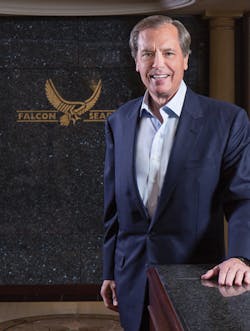Sized to to turn the needle to generate higher returns
PHOTOS BY SYLVESTER GARZA
EDITOR'S NOTE: OGFJ met with David Dewhurst, chairman and CEO of Falcon Seaboard Diversified Inc. and former Lieutenant Governor of Texas, for a one-on-one interview in August. Dewhurst, a Houston native, and the company he co-founded, Falcon Seaboard Resources LLC, launched the $145 million Falcon Seaboard Permian Fund I LP in late July with sights set squarely on, as the name suggests, acquiring acreage in the Permian Basin. Dewhurst talked to us about the fund and seeking outside investments for the first time, as well as his background in both the oil and gas industry and government service.
OGFJ: Falcon Seaboard Diversified Inc. has developed strategic opportunities to capitalize on changes in the ever-evolving energy markets. Tell our readers a little about the firm's history.
DAVID DEWHURST: Falcon Seaboard is a venerable, long-time oil and gas company, originally started by oilman Ted Law in Tulsa as Falcon Drilling Company. The company changed its name to Falcon Seaboard when Law moved operations to Houston. I went to work with Ted Law in 1981, becoming the CEO and president in 1983. In 1989 when Mr. Law passed away, I acquired Law's interests in Falcon Seaboard.
Times were tough in the oil patch-remember "Stay Alive Until '85?" In 1983, I drilled 11 natural gas wells in West Texas, only to find gas prices had fallen and his buyer refused to purchase more natural gas. Faced with a looming problem, I pivoted and entered the natural gas-fired cogeneration business in part to provide a market for his gas. For the next eight years, Falcon Seaboard developed cogeneration plants in Texas, Pennsylvania, and New York, as well as England, Spain, Germany, and South America, while the company invested in oil and gas offshore Gulf of Mexico, Texas, New Mexico, and Canada.
OGFJ: You began your business career in Houston and experienced the oil and gas bust of the 1980s. Is it fair to compare this downturn to that time in the industry's history?
DEWHURST: I feel the oil and gas bust of the early 1980s was tougher than the current 2014-2017 downturn we are experiencing. In the 1980s, Texas' GDP declined and reportedly hundreds of thousands of new or long-time Texas residents left the state for reportedly greener pastures. Having said that, I remember vividly February 2016 and $26 oil, and the recent 20% plus drop in oil prices from $55 barrel to the mid $40s. But technology and best practices have changed the environment from the early 1980s to today. The ability of the industry to drill more wells and increase production with fewer rigs, is nothing short of awesome. Some critics argue it's a double-edged sword, compounding the challenges of surplus oil and lower prices, but we don't live in a central market in the United States, but a free enterprise market economy, and I wouldn't want it any different.
OGFJ: How has being Land Commissioner and Lieutenant Governor of Texas, shaped Falcon Seaboard and its interest in the oil and gas business in Texas?
DEWHURST: Being Texas Land Commissioner, and managing approximately 13 million royalty acres in Texas, and later serving as Lieutenant Governor of Texas, has not shaped Falcon Seaboard or its interest in the oil and gas business. You have to remember that I had been in the oil and gas business for 16 years when I was first elected Land Commissioner, and 20 years when I was first elected Lieutenant Governor. We had drilled wells offshore Gulf of Mexico, Texas, New Mexico, Colorado and Canada, and knew what worked, and what didn't work. What I did learn was the integration of becoming the only state leader with an intimate knowledge of the oil and gas industry plus state and national energy policy. I didn't realize it, but there are not many dual-certified public servants in America who have run oil and gas companies and are wonkish energy policy executives.
OGFJ: Falcon Seaboard investments have traditionally been self-funded. Why is now the time to launch Falcon Seaboard Resources LLC and open up to outside investors?
DEWHURST: Over the past 20 years, Falcon Seaboard has traditionally self-funded, but with our majority partner we have reached a point in developing our Piceance Basin field, with my partner's technical personnel calculating 10 TCF of Gas-In-Place reserves, and I understand 1.5 TCF recoverable at current prices, that it's approaching the time to sell it to a company who will take it to the next level drilling up to 150 wells authorized under our pending environmental impact study.
OGFJ: With an estimate by the US Geological Service of 20 billion barrels of oil to be recovered in the Permian Basin, "Permania" has pushed acquisition prices for acreage higher. Is that a concern as you focus attention on the play?
DEWHURST: Sure, it's a concern if you have to pay higher acreage prices. But I see a successful business model where we are not going to try and corral 20,000 to 40,000 expensive acres, but discipline ourselves to acquire Tier I acreage when it opens, preferably operated, but also non-operated, where we know we can make money, either holding or drilling horizontal wells. Also, we are looking at partnering with an outstanding service company with over 1,000 stripper wells, which I think is an excellent strategy to increase profits.
OGFJ: Some say despite the high acreage costs, technological advances in drilling and completion make the play economic even sub-$40/barrel. Do you think this holds true regardless of OPEC moves and what may be an upward trend in services costs?
DEWHURST: Some do say this, but it appears challenging to be economic across large parts of the Permian in sub-$40/barrel oil. Again, it's a question of rock, precision drilling, maximizing EURs and being a low-cost producer. And all that can be affected by OPEC moves and upward trends in service costs. Hopefully, OPEC has seen first hand what happens to their national economies in a low-price environment, but the industry has to monitor this carefully. I think we are a mistake or two away from lower prices, and a lot of work and some luck to get prices back into the mid-$50s. I don't use "hope" as a strategy. We lease acreage where we are a low-cost producer.
OGFJ: What kind of niche acquisitions does the fund target? Are there specific areas within the Permian that you're focused on?
DEWHURST: In real estate, you make your money when you buy, and there are some parallels to the oil and gas business. Our goal is to acquire Tier I attractively priced deep acreage that's large enough to drill longer laterals, but not large enough to merit some of the high prices we are currently seeing. We're also willing to purchase current production and stripper wells with predictable declines.
OGFJ: Falcon Seaboard Resources was launched to capitalize on opportunities in the Permian that "are not being pursued by larger investment and strategic players." Is that due to price point? Asset size?
DEWHURST: Most of our competitors are larger than we will be. Even private equity firms are often heavily capitalized with $500 million to $1 billion in capital. While that capitalization has advantages, it also makes it harder to turn the needle to generate higher returns. I've watched over the last seven months the business model of two small companies rolling up all or parts of 20 plus small companies, their acreage, production, and stripper wells. Some of it they will sell to create liquidity, but it's a model that many larger companies can't afford to emulate.
OGFJ: Are there current partnerships with E&P companies that you can talk to us about?
DEWHURST: Falcon Seaboard recently signed a Purchase and Sale Agreement with two successful companies, but I prefer to talk specifics later this Fall.
OGFJ: The US drilling industry may be prepared for another investment cycle, but infrastructure-especially in the Permian-could be a limiting factor. Do you see this impacting the investment cycle?
DEWHURST: I also see Permian Basin infrastructure as a limiting factor, that will have to be addressed, particularly in the midstream sector.
OGFJ: Speaking of infrastructure, the desire for properties in the Permian is spreading into the infrastructure and services sectors, is that something Falcon Seaboard is interested in?
DEWHURST: Falcon Seaboard has owned and operated midstream pipelines in different parts of the country. Building a cogeneration plant in Big Spring, Texas, Falcon Seaboard joint ventured several pipelines with then Petrofina. Building a cogeneration plant in upstate New York, Falcon Seaboard spent years permitting natural gas firm capacity on Trans-Canada Pipeline. Then, without Eminent Domain, Falcon Seaboard had to lease acreage from Quebec Province to Plattsburg, New York, from hundreds of land owners, plus bore under streams, to connect our pipeline with our cogeneration plant. Although Falcon Seaboard was not the operator, our partner, SG Interests, did an excellent job in building a 25-mile pipeline that, with compression, will carry up to 300 MMcfd, connecting our Piceance Basin field to interstate carriers.
OGFJ: What about plays outside the Permian? Is the company looking at deals in other areas?
DEWHURST: Two of the advantages of the Permian Basin are being a low-cost producer, and having multiple benches. That same characteristic is present in the better parts of the Powder River Basin.
About the Author
Mikaila Adams
Managing Editor, Content Strategist
Mikaila Adams has 20 years of experience as an editor, most of which has been centered on the oil and gas industry. She enjoyed 12 years focused on the business/finance side of the industry as an editor for Oil & Gas Journal's sister publication, Oil & Gas Financial Journal (OGFJ). After OGFJ ceased publication in 2017, she joined Oil & Gas Journal and was later named Managing Editor - News. Her role has expanded into content strategy. She holds a degree from Texas Tech University.



